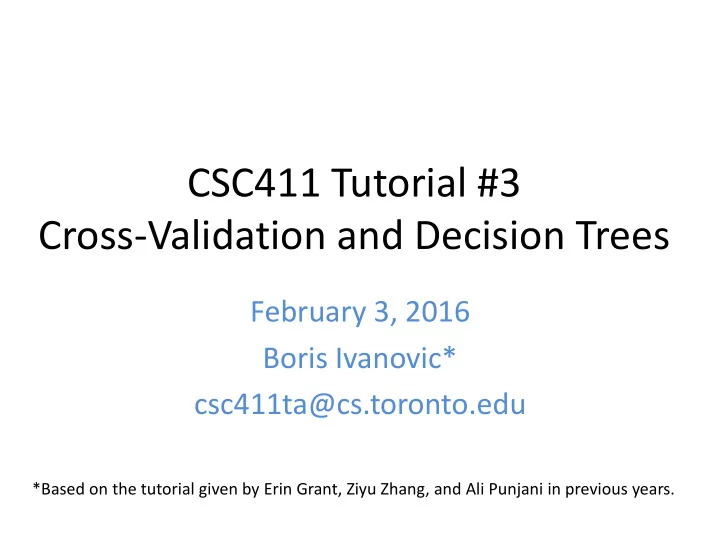

CSC411 Tutorial #3 Cross-Validation and Decision Trees February 3, 2016 Boris Ivanovic* csc411ta@cs.toronto.edu *Based on the tutorial given by Erin Grant, Ziyu Zhang, and Ali Punjani in previous years.
Outline for Today • Cross-Validation • Decision Trees • Questions
Cross-Validation
Cross-Validation: Why Validate? So far: Learning as Optimization Goal: Optimize model complexity (for the task) while minimizing under/overfitting We want our model to generalize well without overfitting . We can ensure this by validating the model.
Types of Validation Hold-Out Validation : Split data into training and validation sets. • Usually 30% as hold-out set. Original Training Set Validation Problems: • Waste of dataset • Estimation of error rate might be misleading
Types of Validation • Cross-Validation : Random subsampling Figure from Bishop, C.M. (2006). Pattern Recognition and Machine Learning . Springer Problem: • More computationally expensive than hold- out validation.
Variants of Cross-Validation Leave- p -out : Use p examples as the validation set, and the rest as training; repeat for all configurations of examples. Problem: • Exhaustive . We have to train and test 𝑂 𝑞 times, where N is the # of training examples.
Variants of Cross-Validation K-fold : Partition training data into K equally sized subsamples. For each fold, use the other K- 1 subsamples as training data with the last subsample as validation.
K-fold Cross-Validation • Think of it like leave- p -out but without combinatoric amounts of training/testing. Advantages : • All observations are used for both training and validation. Each observation is used for validation exactly once . • Non-exhaustive : More tractable than leave- p- out
K-fold Cross-Validation Problems : • Expensive for large N, K (since we train/test K models on N examples). – But there are some efficient hacks to save time… • Can still overfit if we validate too many models! – Solution : Hold out an additional test set before doing any model selection, and check that the best model performs well on this additional set ( nested cross- validation ). => Cross-Validception
Practical Tips for Using K-fold Cross-Val Q: How many folds do we need? A: With larger K , … • Error estimation tends to be more accurate • But, computation time will be greater In practice: • Usually use K ≈ 10 • BUT, larger dataset => choose smaller K
Questions about Validation
Decision Trees
Decision Trees: Definition Goal : Approximate a discrete-valued target function Representation : A tree, of which • Each internal (non-leaf) node tests an attribute • Each branch corresponds to an attribute value • Each leaf node assigns a class Example from Mitchell, T (1997). Machine Learning . McGraw Hill.
Decision Trees: Induction The ID3 Algorithm: while ( training examples are not perfectly classified ) { choose the “most informative” attribute 𝜄 (that has not already been used) as the decision attribute for the next node N (greedy selection) . foreach ( value (discrete 𝜄 ) / range (continuous 𝜄 ) ) create a new descendent of N. sort the training examples to the descendants of N }
Decision Trees: Example PlayTennis
After first splitting the training examples on Outlook… • What should we choose as the next attribute under the branch Outlook = Sunny?
Choosing the “Most Informative” Attribute Formulation : Maximize information gain over attributes Y . H ( PlayTennis ) H ( PlayTennis | Y )
Information Gain Computation #1 High Normal • IG( PlayTennis | Humidity ) = 0.970 − 3 5 0.0 − 2 5 (0.0) = 0.970
Information Gain Computation #2 3 values b/c Temp takes on 3 values! 2 2 1 • IG( PlayTennis | Temp ) = 0.970 − 5 0.0 − 5 1.0 − 5 (0.0) = 0.570
Information Gain Computation #3 • IG( PlayTennis | Wind ) = 0.970 − 2 5 1.0 − 3 5 0.918 = 0.019
The Decision Tree for PlayTennis
Questions about Decision Trees
Feedback (Please!) boris.ivanovic@mail.utoronto.ca • So… This was my first ever tutorial! • I would really appreciate some feedback about my teaching style, pacing, material descriptions, etc … • Let me know any way you can, tell me in person, tell Prof. Fidler, email me, etc … • Good luck with A1!
Recommend
More recommend